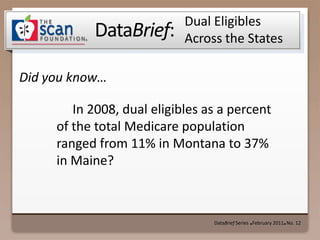
Dual Eligibles by State: 2008 Medicaid and Medicare Enrollment
- 1. DataBrief Series ● February 2011● No. 12 Dual Eligibles Across the States In 2008, dual eligibles as a percent of the total Medicare population ranged from 11% in Montana to 37% in Maine?
- 2. Dual Eligibles’ Eligibility Pathways “Dual eligibles” are low-income individuals who qualify for both Medicare and Medicaid. Low-income Medicare beneficiaries can become eligible for Medicaid through various “eligibility pathways”:1 Medicare beneficiaries can qualify for full Medicaid benefits when they participate in the Supplemental Security Income (SSI) program, which covers individuals at or below 75% of the Federal Poverty Limit (FPL) and couples at 83% of FPL. Medicare beneficiaries can also qualify for Medicaid through the medically needy coverage option. States may choose to provide Medicaid to individuals with higher incomes but who, due to their high medical expenses, have met state “spend-down” requirements. This means that after deducting medical expenses from their monthly income, they are below poverty. Most states also allow individuals who require nursing home care to qualify for Medicaid at 300% of SSI ($2,022 per month in 2011 for individuals 2). In addition, slightly higher income individuals (100% - 200% of FPL) can qualify for partial Medicaid coverage through one of four Medicare Savings Programs.3 Page 2 1 Kaiser Commission on Medicaid and the Uninsured. “Medicaid Financial Eligibility: Primary Pathways for the Elderly and People with Disabilities.” Kaiser Family Foundation. February 2010. 2 Social Security Administration. Accessed at: http://www.ssa.gov/OACT/cola/SSIamts.html, on January 18, 2011. 3 The SCAN Foundation. Fact Sheet No. 17: Medicare Savings Programs. Accessed at: http://www.TheSCANFoundation.org/sites/default/files/INSERT URL. January 2011. DataBrief (2011) ● No. 12
- 3. Page 3 Dual Eligibles as a Percent of the Total Medicare Population by State WA ME MT ND VT NH MN OR MA WI NY ID RI SD CT MI WY PA NJ IA NE DE OH NV IN IL MD WV UT VA D.C. CA CO MO KS KY NC TN OK SC AZ AR NM GA AL MS LA TX 25%+ AK FL 20% to <25% 15% to <20% HI 10% to <15% DataBrief (2011) ● No. 12
- 4. A Clear Policy Connection Individuals who are dually eligible for Medicare and Medicaid are among the poorest and sickest in the United States. On average, dual eligibles consume more Medicare dollars than non-duals and while they make up only 18% of Medicaid enrollees, dual eligibles account for 46% of total Medicaid spending.1 The proportion of Medicare beneficiaries who are dually eligible for Medicaid varies substantially across states, as does Medicaid spending per dual eligible.2 State variation in the number of Medicare beneficiaries living in poverty depends on each state’s financial eligibility criteria for Medicaid. States with the highest percentages of dual eligibles relative to their total Medicare population have high rates of poverty and/or their Medicaid programs cover individuals at higher levels of the federal poverty level. The Affordable Care Act established the Federal Coordinated Health Care Office to improve care delivery and lower the cost of care for dual eligibles. This office has the authority to fund innovative state and federal efforts to coordinate care for this vulnerable population. The Office will need to take into consideration the differences among states in the number and proportion of total Medicare beneficiaries that are dual eligibles when identifying opportunities for demonstrations and creating policy recommendations. This analysis uses the 2008 Medicare claims data to determine the total number of Medicare-only beneficiaries by state. It is limited to individuals who were enrolled in the fee-for service, or traditional, Medicare program at any point in 2008. To determine the total number of dual eligibles by state, this analysis uses the FY 2008 Medicaid Statistical Information System (MSIS). Dual eligibles are defined as Medicare beneficiaries who were eligible for full Medicaid benefits or one of the Medicare Savings Programs in FY2008. The analysis includes individuals who were listed as dual eligible, though the type of dual is unknown. All states with the exception of Hawaii have completed their FY 2008 MSIS reporting. To determine the number of dual eligbiles living in Hawaii, the analysis uses FY 2007 data. DataBrief (2011) ● No. 12 Page 4 1 MedPAC. “Report to Congress: Aligning Incentives in Medicare.” June 2010. 2 Kaiser Commission on Medicaid and the Uninsured. “Dual Eligibles: Medicaid’s Role for Low-Income Medicare Beneficiaries.” Kaiser Family Foundation. February 2009.